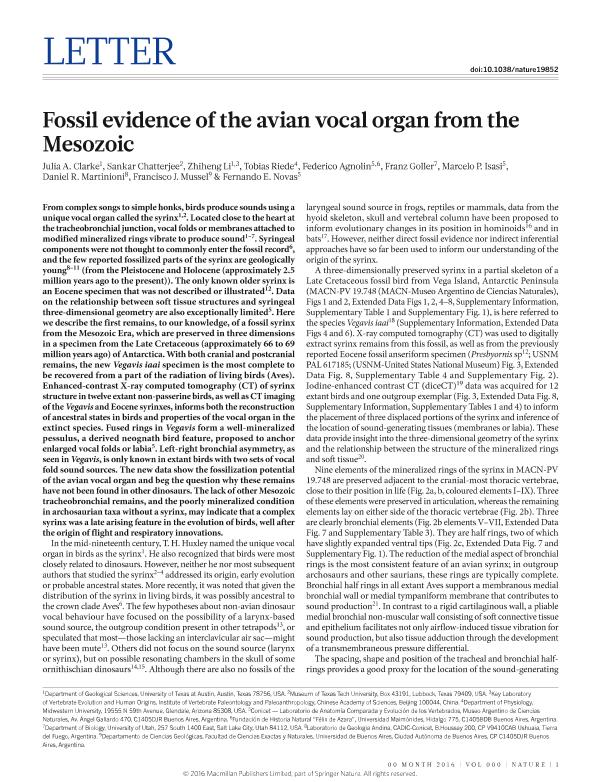Mostrar el registro sencillo del ítem
dc.contributor.author
Clarke, Julia A.
dc.contributor.author
Chatterjee, Sankar
dc.contributor.author
Li, Zhiheng
dc.contributor.author
Riede, Tobias
dc.contributor.author
Agnolin, Federico

dc.contributor.author
Goller, Franz

dc.contributor.author
Isasi, Marcelo Pablo

dc.contributor.author
Martinioni, Daniel Roberto

dc.contributor.author
Mussel, Francisco J.
dc.contributor.author
Novas, Fernando Emilio

dc.date.available
2018-11-20T19:51:35Z
dc.date.issued
2016-10
dc.identifier.citation
Clarke, Julia A.; Chatterjee, Sankar; Li, Zhiheng; Riede, Tobias; Agnolin, Federico; et al.; Fossil evidence of the avian vocal organ from the Mesozoic; Nature Publishing Group; Nature; 538; 7626; 10-2016; 502-505
dc.identifier.issn
0028-0836
dc.identifier.uri
http://hdl.handle.net/11336/64786
dc.description.abstract
From complex songs to simple honks, birds produce sounds using a unique vocal organ called the syrinx. Located close to the heart at the tracheobronchial junction, vocal folds or membranes attached to modified mineralized rings vibrate to produce sound. Syringeal components were not thought to commonly enter the fossil record, and the few reported fossilized parts of the syrinx are geologically young (from the Pleistocene and Holocene (approximately 2.5 million years ago to the present)). The only known older syrinx is an Eocene specimen that was not described or illustrated. Data on the relationship between soft tissue structures and syringeal three-dimensional geometry are also exceptionally limited. Here we describe the first remains, to our knowledge, of a fossil syrinx from the Mesozoic Era, which are preserved in three dimensions in a specimen from the Late Cretaceous (approximately 66 to 69 million years ago) of Antarctica. With both cranial and postcranial remains, the new Vegavis iaai specimen is the most complete to be recovered from a part of the radiation of living birds (Aves). Enhanced-contrast X-ray computed tomography (CT) of syrinx structure in twelve extant non-passerine birds, as well as CT imaging of the Vegavis and Eocene syrinxes, informs both the reconstruction of ancestral states in birds and properties of the vocal organ in the extinct species. Fused rings in Vegavis form a well-mineralized pessulus, a derived neognath bird feature, proposed to anchor enlarged vocal folds or labia. Left-right bronchial asymmetry, as seen in Vegavis, is only known in extant birds with two sets of vocal fold sound sources. The new data show the fossilization potential of the avian vocal organ and beg the question why these remains have not been found in other dinosaurs. The lack of other Mesozoic tracheobronchial remains, and the poorly mineralized condition in archosaurian taxa without a syrinx, may indicate that a complex syrinx was a late arising feature in the evolution of birds, well after the origin of flight and respiratory innovations.
dc.format
application/pdf
dc.language.iso
eng
dc.publisher
Nature Publishing Group

dc.rights
info:eu-repo/semantics/openAccess
dc.rights.uri
https://creativecommons.org/licenses/by-nc-sa/2.5/ar/
dc.subject
Vegavis Iaai
dc.subject
Vocal Organ
dc.subject
Antarctica
dc.subject.classification
Meteorología y Ciencias Atmosféricas

dc.subject.classification
Ciencias de la Tierra y relacionadas con el Medio Ambiente

dc.subject.classification
CIENCIAS NATURALES Y EXACTAS

dc.title
Fossil evidence of the avian vocal organ from the Mesozoic
dc.type
info:eu-repo/semantics/article
dc.type
info:ar-repo/semantics/artículo
dc.type
info:eu-repo/semantics/publishedVersion
dc.date.updated
2018-05-30T15:32:44Z
dc.journal.volume
538
dc.journal.number
7626
dc.journal.pagination
502-505
dc.journal.pais
Reino Unido

dc.journal.ciudad
Londres
dc.description.fil
Fil: Clarke, Julia A.. University of Texas at Austin; Estados Unidos
dc.description.fil
Fil: Chatterjee, Sankar. Texas Tech University; Estados Unidos
dc.description.fil
Fil: Li, Zhiheng. University of Texas at Austin; Estados Unidos. Chinese Academy of Sciences; República de China
dc.description.fil
Fil: Riede, Tobias. Midwestern University; Estados Unidos
dc.description.fil
Fil: Agnolin, Federico. Consejo Nacional de Investigaciones Científicas y Técnicas. Oficina de Coordinación Administrativa Parque Centenario. Museo Argentino de Ciencias Naturales “Bernardino Rivadavia”; Argentina. Universidad Maimónides; Argentina
dc.description.fil
Fil: Goller, Franz. University of Utah; Estados Unidos
dc.description.fil
Fil: Isasi, Marcelo Pablo. Consejo Nacional de Investigaciones Científicas y Técnicas. Oficina de Coordinación Administrativa Parque Centenario. Museo Argentino de Ciencias Naturales “Bernardino Rivadavia”; Argentina
dc.description.fil
Fil: Martinioni, Daniel Roberto. Consejo Nacional de Investigaciones Científicas y Técnicas. Centro Austral de Investigaciones Científicas; Argentina
dc.description.fil
Fil: Mussel, Francisco J.. Universidad de Buenos Aires. Facultad de Ciencias Exactas y Naturales. Departamento de Ciencias Geológicas; Argentina
dc.description.fil
Fil: Novas, Fernando Emilio. Consejo Nacional de Investigaciones Científicas y Técnicas. Oficina de Coordinación Administrativa Parque Centenario. Museo Argentino de Ciencias Naturales “Bernardino Rivadavia”; Argentina
dc.journal.title
Nature

dc.relation.alternativeid
info:eu-repo/semantics/altIdentifier/url/http://www.nature.com/nature/journal/v538/n7626/full/nature19852.html
dc.relation.alternativeid
info:eu-repo/semantics/altIdentifier/doi/https://doi.org/10.1038/nature19852
Archivos asociados
